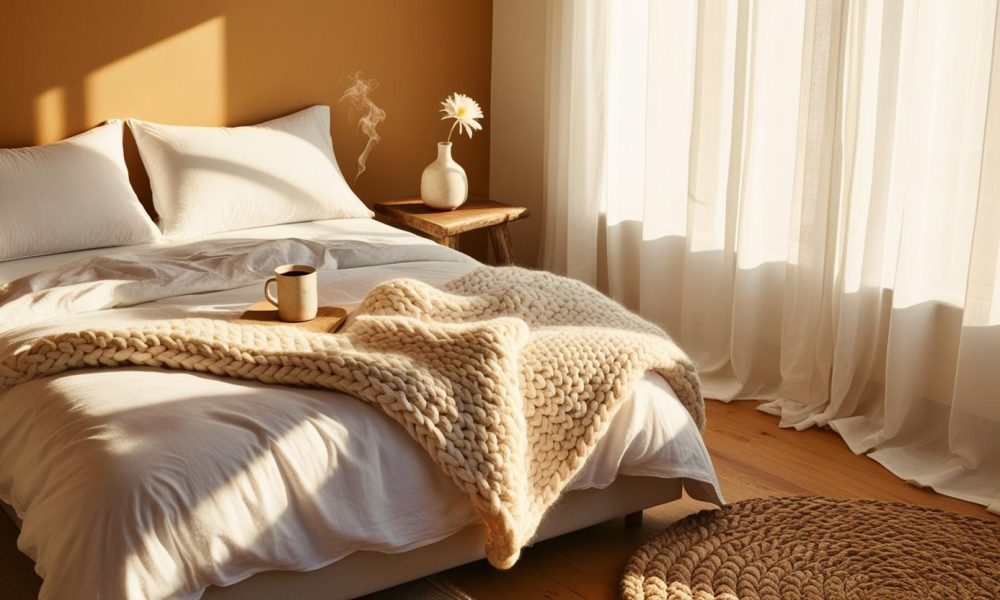Types of Sustainable Bedding Materials
Discover the best types of sustainable bedding materials that combine eco-conscious living with cloud-like comfort. From organic cotton to recycled fibers, these materials elevate your sleep space while caring for the planet.
Key Takeaways
- Organic cotton, bamboo, hemp, linen, and recycled fibers are leading sustainable bedding materials.
- Certifications like GOTS and OEKO-TEX ensure eco-friendly and safe bedding choices.
- Sustainable bedding promotes better sleep quality and reduces environmental impact.
Why Sustainable Bedding Materials Matter
Traditional bedding production often involves harsh chemicals, water-intensive farming, and synthetic fibers that harm the environment. Choosing types of sustainable bedding materials helps reduce waste, supports biodiversity, and promotes toxin-free, breathable sleep fabrics.
When you switch to eco-friendly bedding, you’re investing in healthier sleep and a more sustainable planet. For more ideas, check out our eco-friendly sleep choices guide or explore curated lists like The Good Trade’s sustainable bedding roundup.
The Top Types of Sustainable Bedding Materials
Organic Cotton: Soft, Safe, and Sustainable
Grown without harmful pesticides, organic cotton is gentle on your skin and the environment. It’s breathable, hypoallergenic, and supports soil health. For a complete eco-friendly upgrade, explore our article on organic mattress options or see Azure Road’s natural and organic bedding brands guide.

Bamboo: Naturally Luxurious
Bamboo is a fast-growing, renewable resource that requires minimal water and no pesticides. Bamboo bedding—especially lyocell or Tencel—feels silky-soft, wicks away moisture, and is naturally antimicrobial, making it ideal for hot sleepers.

Recycled Fibers: Turning Waste into Comfort
Bedding made from post-consumer recycled cotton or PET plastic bottles offers durability and reduces landfill waste. These types of sustainable bedding materials give discarded resources a second life. Learn more in our sustainable bedding options guide or read Polygiene’s resource on sustainable bedding.

Hemp: Naturally Durable
Hemp is one of the oldest natural fibers, valued for its strength and minimal water needs. Hemp bedding is biodegradable, breathable, and softens beautifully over time, making it a smart long-term choice.
Linen: Timeless and Earth-Friendly
Made from flax, linen is durable, eco-friendly, and naturally cooling—perfect for warm climates. Its antibacterial properties and classic look make it a luxurious yet sustainable bedding option. For additional insights, explore Everlasting Fabric’s guide on top sustainable bedding materials.

Understanding Rayon, Viscose, and Tencel
While bamboo rayon and viscose originate from natural materials, their chemical-heavy processing makes them less eco-friendly. In contrast, Tencel (lyocell) is produced in a closed-loop system that reuses water and solvents, making it a truly sustainable choice.
For more insights on textile sustainability, see this fiber sustainability breakdown by Sustain Your Style.
Tips for Choosing Sustainable Bedding
Look for Certifications
Eco-labels ensure product integrity and environmental safety. Key certifications include:
- GOTS – Global Organic Textile Standard
- OEKO-TEX – Tested for harmful substances
- FSC – Responsible forestry practices for bamboo products
Think Beyond the Fabric
Sustainability goes beyond materials—it includes fair labor, eco-friendly packaging, and ethical sourcing. Brands featured on Green Hive showcase holistic eco practices.
The Cozy Wrap-Up
Choosing the right types of sustainable bedding materials benefits both your health and the planet. Whether it’s organic cotton, bamboo, or recycled fibers, eco-friendly bedding is a step toward a greener future. Want to combine sustainability with style? See our maximalist bedding styles for bold, eco-loving designs.
FAQ
- What are the best types of sustainable bedding materials?
- Organic cotton, bamboo lyocell (Tencel), hemp, linen, and recycled fibers are among the top eco-friendly bedding choices.
- Is bamboo bedding really sustainable?
- Yes, especially when labeled Tencel or lyocell, which are made with closed-loop, low-impact processes.
- How do I verify that my bedding is sustainable?
- Look for certifications like GOTS, OEKO-TEX, or FSC to ensure authenticity and eco-friendly standards.
- Is linen better than cotton for sustainability?
- Linen typically requires fewer resources and lasts longer, though both materials are sustainable when grown organically.
Learn more about eco-conscious sleep solutions in our comprehensive bedding guide.























